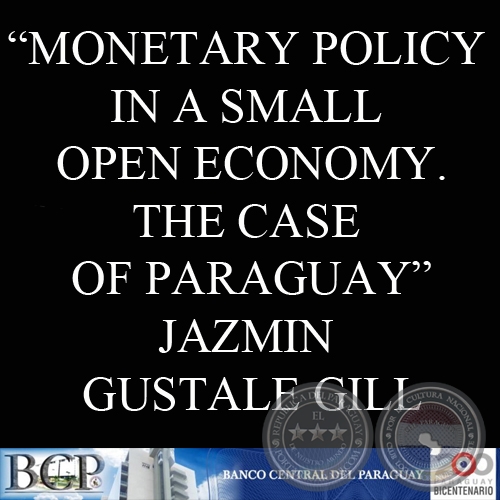REPÚBLICA DEL PARAGUAY
BIBLIOTECA VIRTUAL - DOCUMENTOS DE INVESTIGACIÓN DEL BANCO CENTRAL DEL PARAGUAY
MONETARY POLICY IN A SMALL OPEN ECONOMY. THE CASE OF PARAGUAY (JAZMIN GUSTALE GILL)

MONETARY POLICY IN A SMALL OPEN ECONOMY.
THE CASE OF PARAGUAY.
JAZMIN GUSTALE GILL
JUNE, 2010.
RESEARCH PROJECT
MASTER IN MACROECONOMIC POLICY AND
FINANCIAL MARKETS
ABSTRACT
The objective of this document is to characterize the monetary policy in a small open economy and derives the corresponding monetary policy rules. Specifically, this paper contrasts a Taylor rule for Paraguay with analogous monetary policies. To this end, a small new Keynesian macroeconomic model is calibrated and the parameters are chosen using Paraguay as a benchmark of small open economy. The model incorporates equations for the home and foreign demand and supply and a risk sharing condition. Also include a rule for monetary policy decisions in the form of goal directed monetary policy (targeting rule) and monetary policy instrument (Taylor rule).
ACKNOWLEDGMENTS
The author would like to acknowledge Stefano Gnocchi for the outstanding support. The author is also grateful for comments on colleagues at the Barcelona Graduate School of Economics, particularly Vicente Rios and Marjan Aikimbaeva. The author is also grateful for the valuable comments on the Paraguayan economy from Bernardo Dario Rojas, of the Central Bank of Paraguay, and Santiago Pena, of the International Monetary Fund. Special thanks to Holger Insfran and Jorge Burgos Gorostiaga from the Central Bank of Paraguay. Gratitude is due to Juan Carlos Conesa and Hugo Rodriguez for the research assistant. The views expressed in this document, as well as any errors or omissions, are the sole responsibility of the author, and do not necessarily reflect the opinions of the Barcelona Graduate School of Economics and the Central Bank of Paraguay.
INTRODUCTION
The main motivation of this research work is that the Central Bank of Paraguay has announced a change in the current monetary policy objective based on the control of monetary aggregates, to an inflation targeting approach. The monetary authorities would need to adopt a more preventive posture to potential shocks that could turn aside from the inflation target. In this context the development of models capable to describe and analysis the current policy objective is crucial.
When analyzing monetary policy objectives in open economies, the role of objective variables like exchange rate, inflation and output gap needs to have a special consideration. This work addresses the importance of these variables in a small open economy setting. It also implies a distinction between the consumer price index and the price index inflation. The small open economy framework can be used to assess the implications of alternative monetary policy rules for an open economy.
This paper develops an open economy extension of the basic New Keynesian model of a small open economy model as a limiting case of a two country dynamic general equilibrium framework featuring monopolistic competition and price stickiness. Moreover, the framework assumes no trade frictions and perfect capital markets. The structure presented includes the small open economy setting developed by De Paoli (2006) and Gali (2007). This work allows analyzing the case of two policy rules for central banks: targeting and Taylor-type regimes. Moreover, study what is the measure of inflation that the monetary authority should seek to stabilize. Finally, this framework is used to determine the implications of the alternative rules and compared them to the Taylor rule for Paraguay.
This document also illustrates some of the issues that emerge in the analysis of the different rules. When comparing different targeting rules, inflation targeting is the preferred policy for low levels of variances. When analyzing Taylor rules, producer price index inflation is the ideal policy rule for the 4 different calibrations proposed. When looking to the Taylor rule for Paraguay, the smallest variances values are attained when the monetary authority responds with an anti-inflation plan. Our results suggest that including the inflation as part of the stabilization goals of monetary policy can be welfare improving, in terms of little variances, from a small open economy point of view.
The paper is structured as follows. Section 2 introduces the model and derives a simple representation of the small open economy equilibrium dynamics. Section 3 is dedicated to the derivation of the monetary policy rules. Section 3.1 assesses the merits of three Targeting Rules: classical, inflation and exchange rate target. Section 3.2 discusses three different Taylor-type rules, a classical Taylor rule and two policies that fully stabilize CPI and PPI inflation, respectively. Section 4 discuss the Monetary Policy of Paraguay and derive a Taylor rule for the economy. Finally, to enrich the study, section 5 contains a numerical analysis of the model and presents impulse responses and variance of the target variables, as a measure of welfare losses. Section 6 includes concluding remarks.
BIBLIOTECA VIRTUAL DEL BCP
BANCO CENTRAL DEL PARAGUAY
LIBRO DIGITAL
Fuente digital : www.bcp.gov.py
Todos los derechos reservados
Desde el Paraguay para el Mundo!
Acerca de PortalGuarani.com | Centro de Contacto